Neighborhood Hawks Part I:
In the Backyard
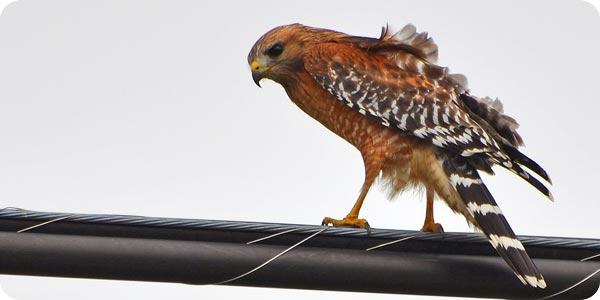 Red-shouldered Hawk - Local photo by Susie Kelly
Red-shouldered Hawk - Local photo by Susie Kelly
For many, hawks are our most striking birds: large, imposing, often associated with visions of noble soaring on the aether with their magisterial gaze cast down on the crawling world below.
He clasps the crag with crooked hands;
Close to the sun in lonely lands,
Ring'd with the azure world, he stands.
The wrinkled sea beneath him crawls;
He watches from his mountain walls,
And like a thunderbolt he falls.
- Tennyson, “The Eagle”
But in our experience, we’ve found that many casual birdwatchers have trouble identifying our most common hawks. So to bring these magnificent birds back into the realm of our everyday experience, we here present a quick guide to the birds of prey you are actually likely to see around a Bay Area neighborhood.
The backyard bird-eaters: Coops and Sharpies
If you see a hawk going after your feeder birds, it is in the great majority of cases one of these two species: the Cooper's hawk or the sharp-shinned hawk. “Coops” and “Sharpies” (or “Sharps” if you feel that diminutive “-ies” are inappropriately cuddly for predatory application) are closely related, notoriously similar birds. Cooper’s hawks are bigger and sharp-shinned hawks are smaller, but a small male Cooper’s can be very close in size to a large female sharp-shinned. (Hawks are generally victim to what I remember Golden Gate Raptor Observatory director Allen Fish once referring to as “the terrible disease called reverse sexual dimorphism,” in which females are the larger sex.)
See the comparison below for how to distinguish them, but first a general note: both of these two species have a distinct juvenile (first year) and adult plumage. Adults generally have reddish horizontal barring on their breast and a dark grayish back side. Juvies have brown vertical streaks on a light breast and a brownish back.
|
Juvie Coop |
Adult Coop |
Juvie Sharpie |
Adult Sharpie |
|
Cooper's Hawk
|
Sharp-shinned Hawk
|
There are lots of other fine points, which you can explore in this in-depth comparison from Cornell’s Project Feederwatch. With practice you can develop a pretty reliable sense of the subtler differences, allowing you to categorize a hawk at a glance. If you’re new to the Coop-Sharpie game, the above tips are some of the easier ones to apply. But sometimes you don’t get a good look and you just can’t tell!
Two bigger hawks: Red-tails and Red-shoulders
The Coops and Sharpies above belong to the Accipiter genus, known for short wings, long tails, lots of flapping, and sneak attacks out of the trees. Red-tailed hawks and red-shouldered hawks, in contrast, belong to the Buteo genus, characterized by broad wings, shorter tails, and skillfulness at cruising around in unflapping circles (they will also hunt from poles and wires).
The red-tailed hawk is the most common hawk both here and across the country. If you see a big hawk that you want to identify, the first question is: is it a red-tail? In some cases, they are made easy to recognize by their brick red tails. But two important disclaimers need to be made: juvenile birds do not have red tails and even adult tails won’t look very red when seen from below (i.e. when a bird is soaring above you).
|
|
|
If you see one perched, a good thing to look for is their combination of a dark head, a light (i.e. mostly unstreaked) bib at the top of the breast, and then streaking below that on the rest of the breast and belly. If you see one flying right above you, you can also look for the “patagial marks,” dark patches on the inner, front edges of the wings shared by none of our other raptors. Red-tails are much bigger than Cooper’s Hawks and are sometimes mistaken for eagles when suddenly seen at a short distance by people not used to such close encounters. They eat birds less frequently than the accipiters, generally favoring a variety of mammals. And snakes. They seem to like snakes.
|
Juvenile Red-shoulder by Jan Arendtsz |
The red-shouldered hawk is distinctly less common, but is still seen fairly frequently in neighborhoods that have some trees and are not too completely urbanized. While belonging to the buteo genus, it is true that red-shoulders are relatively accipiter-like: they often hang out in trees and do a fair bit of flapping in flight, although they are capable of soaring in fairly relaxed fashion. Adults can be recognized by their vivid black and white checkering on the wings, thin white bands on black tails, and red breasts. Quite dramatic. Juvenile red-shoulders are rather more muted versions of the same general pattern, with browns replacing blacks and vertical streaking replacing the red breasts. Compared to juvie red-tails, they will not show a light bib at the top of their breast, but have streaking continuing all the way up to the neck. Red-shoulders are fairly flexible eaters, but rarely go chasing after birds in your yard. Smaller rodents, lizards, snakes and amphibians make up the larger part of their diet.
|
Abridged comic from bird and moon. |
Turkey VultureThe turkey vulture is not really a hawk: they lack the tearing beak and talons and belong to a different genetic lineage. But they are big, they do eat animals, and they are the most common big bird to see soaring around in the sky around here. They are generally pretty easy to recognize, even at a distance: tiny red heads, black feathers (wings are two-toned, black and silver, when seen from beneath while flying), and a distinctive flight style characterized by a strong v-shape to the wing position and frequent little rocks and wobbles. And while not generally numbered among our most beautiful birds, vultures perform an invaluable service in cleaning up carrion.
|
Would you like to learn our other local hawks beyond the backyard? Master harriers, kites, falcons, and more in Local Hawks: Part II.


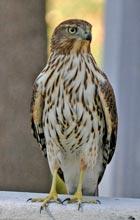
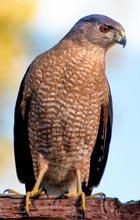
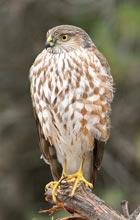
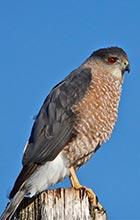
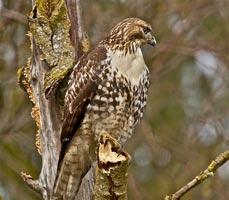
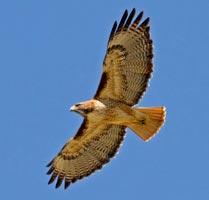
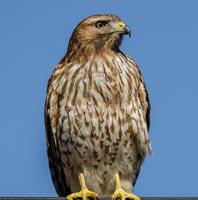

 Small head, v-shape to wings, wobbles in flight - easy to recognize even far away.
Small head, v-shape to wings, wobbles in flight - easy to recognize even far away.